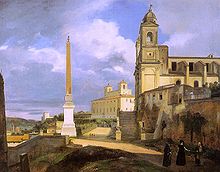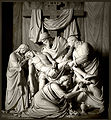- Trinità dei Monti
-
 The Church in the Napoleonic era. François Marius Granet, La Trinité-des-Monts et la Villa Médicis, à Rome (1808).
The Church in the Napoleonic era. François Marius Granet, La Trinité-des-Monts et la Villa Médicis, à Rome (1808).
The church of the Santissima Trinità dei Monti (often called merely the Trinità dei Monti) is a late Renaissance titular church in Rome, central Italy. It is best known for its commanding position above the Spanish Steps which lead down to the Piazza di Spagna. The church and its surrounding area (including the Villa Medici) are the property of the French State.
Contents
History
In 1494, Saint Francis of Paola, a hermit from Calabria, bought a vineyard from the papal scholar and former patriarch of Aquileia, Ermolao Barbaro, and then obtained the authorization from Pope Alexander VI to establish a monastery for the Minimite Friars. In 1502, Louis XII of France began construction of the church of the Trinità dei Monti next to this monastery, to celebrate his successful invasion of Naples. Building work began in a French style with pointed late Gothic arches, but construction lagged.[citation needed]
The present Italian Renaissance church was eventually built in its place and finally consecrated in 1585 by the great urbanizer Pope Sixtus V, whose via Sistina connected the Piazza della Trinità dei Monti (outside the church) to the Piazza Barberini across the city. The architect of the facade is not known for certain, but Wolfgang Lotz suggests that it may have originated in a design by Giacomo della Porta (a follower of Michelangelo), who had built the church of San Anastasio dei Greci, which has similarities, a little earlier.[1] The double staircase in front of the church was by Domenico Fontana.[2]
In front of the church stands the Obelisco Sallustiano, one of the many obelisks in Rome, moved here in 1789. It is a Roman obelisk in imitation of Egyptian ones, originally constructed in the early years of the Roman Empire for the Gardens of Sallust near the Porta Salaria.[3] The hieroglyphic inscription was copied from that on the obelisk in the Piazza del Popolo.
During the Napoleonic occupation of Rome, the church, like many others, was despoiled of its art and decorations. In 1816, after the Bourbon restoration, the church was restored at the expense of Louis XVIII.[4]
Interior
In the first chapel to the right is a Baptism of Christ and other scenes of the life of John the Baptist by the Florentine Mannerist painter Giambattista Naldini. In the third chapel on the right is an Assumption of the Virgin by a pupil of Michelangelo, Daniele da Volterra (the last figure on the right is said to be a portrait of Michelangelo).[5] In the fourth chapel, the Cappella Orsini, are scenes of the Passion of Christ by Paris Nogari and the funeral monument of Cardinal Rodolfo Pio da Carpi by Leonardo Sormani.[6] In a chapel near the high altar is a canvas of the Crucifixion painted by Cesare Nebbia.
In the Cappella Pucci, on the left, are frescoes (1537) by Perino del Vaga finished by Federico and Taddeo Zuccari in 1589. The second chapel on the left has a well-known canvas of the Deposition in grisaille, by Daniele Volterra, which imitates in trompe l'oeil a work of sculpture; flanking it are frescoes by Paolo Céspedes and Cesare Arbasia. The first chapel on the left has frescoes by Nebbia. In the sacristy anteroom are more frescoes by Taddeo Zuccari: a Coronation of the Virgin, an Annunciation, and a Visitation.
The frescoes in the dome are by Perino del Vaga[7]
In a niche along a corridor that opens onto the cloister, is the fresco (reputed to be miraculous) of the Mater Admirabilis, depicting the Virgin Mary, painted by a young French girl in 1844.[8]
-
Deposition by Daniele da Volterra
-
Assumption of the Virgin by Daniele da Volterra
-
The Virgin Mary (the fresco known as 'Mater Admirabilis')
Convent
The refectory has a frescoed ceiling by Andrea Pozzo. In the cloister there is an astronomical table by E. Maignan (1637). Along a corridor are the anamorphic frescoes (steeply sloping perspectives that have to be viewed from a particular point to make pictorial sense) portraying St John on Patmos and St Francis of Paola as a hermit. An upper room was painted with ruins by Charles-Louis Clérisseau.
Religious affiliations
The kings of France remained patrons of the church until the French Revolution and the church continued to be the church of the Minimite Friars until its partial destruction in 1798.[9]
It has been a titular church since the Titulus Santissimae Trinitatis in Monte Pincio was established by Pope Sixtus V in 1587 and has been held ever since by a French Cardinal. The current (2010) Cardinal Priest is Philippe Barbarin, Archbishop of Lyon and Primate of the Gauls.
By the Diplomatic Conventions of 14 May and 8 September 1828 between the Holy See and the Government of France the church and monastery were entrusted to the 'Religieuses du Sacré-Coeur de Jésus' (Society of the Sacred Heart), a French religious order, for the purpose of educating young girls.
In 2003 the French government were proposing to make funds available for necessary work on the church but was concerned that the Society might find it difficult to continue their work there in the future and in March 2003 the Society decided that it would withdraw from the Trinità no later than the summer of 2006. On July 12, 2005, the Vatican and the French Embassy to the Holy See announced that the Church, Convent and school would be entrusted, from 1 September 2006 to the Monastic Fraternities of Jerusalem.[10]
See also
References
Books
- Hutton, Edward: Rome (1911. 7th revised & enlarged edn:1950)
- Lotz, Wolfgang: Architecture in Italy 1500-1600. (1974. Yale U.P.edition 1995)
- Macadam, Alta: Rome (Blue Guides. 6th edition. London. 1998)
External Links
Notes
- ^ Lotz p.123, and also on p.184 (note 40) referring, on the question of the authorship, typology and dating of the facades of S Atanasio and this church, to G. Giovannoni: Saggi sull'architettura del rinascimento (2nd edn. Milan. 1953) pp.219ff. Touring Club Italiano, Roma e dintorni (1965:269) attributed the facade to Carlo Maderno but Howard Hibberd's Carlo Maderno and Roman Architecture 1580-1630 (London. 1971) does not mention this church as a work of Maderno or even as a work wrongly attributed to him.
- ^ Macadam p.171; TCI 1965.
- ^ Touring Club Italiano 1965:269.
- ^ Macadam p.171
- ^ Macadam p.171
- ^ TCI 1965:270.
- ^ Macadam p.171. Works of art not mentioned by Macadam are mentioned on the website of Romecity.it, cited below.
- ^ Visionsofjesuschrist.com
- ^ Hutton p.245
- ^ RSJCinternational.org, website of the Society of the Sacred Heart for the history of the change
Coordinates: 41°54′23″N 12°29′01″E / 41.90639°N 12.48361°E
Categories:- Titular churches in Rome
- Renaissance architecture in Rome
- Buildings and structures completed in 1585
- 19th-century church buildings
Wikimedia Foundation. 2010.








